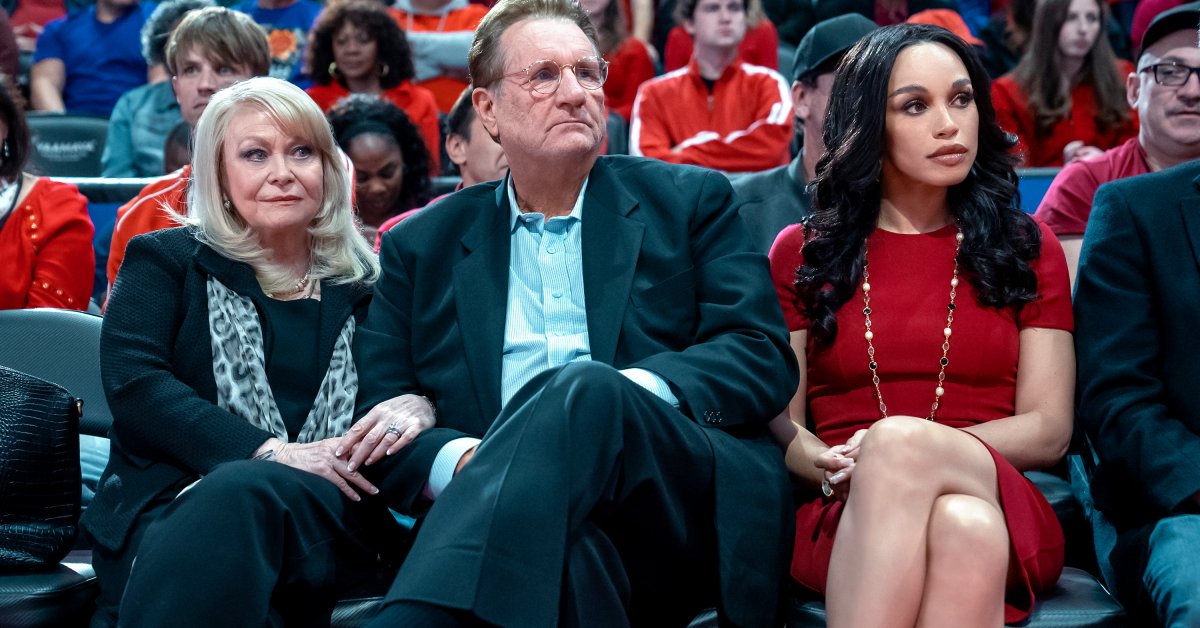In April 2014, a tape was leaked of 80-year-old then-Clippers owner Donald Sterling making racist comments to his 31-year-old mistress, V. Stiviano, an incident that ballooned into one of the biggest scandals in the NBA and changed the league forever. The recording incited a media frenzy—which led to Sterling selling the team and earning a lifetime ban from the NBA—and brought to light Sterling’s long and uncomfortable history of racial discrimination, pushing long overdue conversations about race and structural power in not only the NBA, but the world at large.
Read more: The NBA’s Response to Donald Sterling’s Racism Got Everything Right
Now, a decade later, this shocking story is still making waves in Clipped, a new six-episode mini series that revisits the scandal that rocked the NBA. The show, released today (June 4) on FX, stars Ed O’Neill as Sterling, Cleopatra Coleman as Stiviano, and Jacki Weaver as Rochelle “Shelley” Sterling, Donald’s wife. The series aims to provide context around one of the most sensational moments in NBA history and how it impacted power dynamics between players and owners not just in the NBA but across all sports. Adapted from ESPN’s 30 for 30 podcast The Sterling Affair, the series also looks at how the scandal affected the team and its leader, then-head coach of the Clippers, Doc Rivers (played by Laurence Fishburne), who against all odds, seemed to finally be breaking the “Clippers Curse,” that had plagued the under-resourced and down-on-its-luck team for the majority of Sterling’s ownership.
Here’s what to know about the scandalous true story behind Clipped.
What to know about Donald Sterling’s long and problematic history with racism
Though Donald Sterling’s blatantly racist remarks on the leaked tape were shocking, to many they did not come as a surprise. Sterling had a long, if not especially conspicuous, history of racial discrimination in the world of sports and beyond. Sterling, who made his fortune in real estate, was sued by the US Department of Justice in 2006 for longtime housing discrimination, a lawsuit that included claims the Sterlings would not rent apartments to tenants that were Black, Hispanic or had children. As an NBA team owner, he was accused of racist behavior multiple occasions, including a 2009 employment discrimination lawsuit case brought against him by NBA Hall of Famer Elgin Baylor, who was the Clippers’ general manager for 22 years. Baylor quoted Sterling as saying he wanted the Clippers to be comprised of “poor black boys from the South.” Around the league, there was a widespread understanding of how poorly he treated the largely Black Clippers players, whom he balked at compensating well, but paraded publicly as assets to his wealth.
In The Sterling Affair, former Clippers players Blake Griffin, Ryan Hollins, and Matt Barnes detail how Sterling would often bring people to the locker room to look at the players, while fetishizing their physiques, exhibiting what sports writer Adrian Wojnarowski termed a “plantation prism” mindset; Griffin also said that Sterling would often feel their muscles and encourage his guests to do the same. In an extended version of the leaked tape that appeared in Deadspin, Sterling’s comments further illuminate this outlook, where he emphasized what his ownership provides players.
“I support them and give them food, and clothes, and cars, and houses,” he said. “Who gives it to them? Does someone else give it to them? Do I know that I have—Who makes the game? Do I make the game, or do they make the game?”
Who is V. Stiviano, Sterling’s former mistress?

In Clipped, V. Stiviano is a young and ambitious (if fame-hungry) antiheroine, who provides the foil to Shelley Sterling, Donald’s shrewd and wary wife of over 50 years. In real life, Stiviano, who became a tabloid magnet during the scandal thanks to antics like wearing a face-obscuring visor, roller blading for the paparazzi, and claiming that she would one day be president, was a flashy and nakedly ambitious hustler whose contradictions as a person complicated any easy categorization of her. Born María Vanessa Perez, she changed her name to V. Stiviano in 2010 because she felt she was never “fully accepted because of my race;” according to the LA Times, she also went by the names Monica Gallegos, Vanessa Perez, and Maria Valdez.
While Stiviano and her lawyers denied that was ever Sterling’s girlfriend, she told ABC News in a bizarre interview with Barbara Walters that she was his personal assistant. In the same interview, she also referred to herself as Sterling’s “right-hand arm man.”
“I’m Mr. Sterling’s everything,” she told Walters. “I’m his confidant, his best friend, his silly rabbit.” LA Times also reported that Stiviano was listed as the director of the Donald T. Sterling Charitable Foundation in an advertisement for a 2011 charity luncheon.
On her Instagram, which was very active at the time of the tape’s leak, Stiviano self-identified in her bio as “Artist, Lover, Writer, Chef, Poet, Stylist, Philanthropist.” Stiviano also became the adoptive mother of two pre-teen boys in 2014, at the height of the scandal, after fostering them for three years prior.
What was on the transcript of the leaked Donald Sterling tape?

The infamous tape recording that brought down Sterling was a recording of a heated conversation between him and Stiviano that took place on April 9, 2014 after she posted a photo on Instagram of herself with NBA legend Magic Johnson at a Dodgers game. The tape was leaked to TMZ on April 25, 2014; Stiviano’s lawyers claimed that she did not make recording public. During the exchange— one of hundreds she claimed she recorded because of Sterling’s frequent forgetfulness—Sterling rants about Stiviano posting pictures of herself with Black people on social media.
“It bothers me a lot that you want to broadcast that you’re associating with Black people. Do you have to?” he asks at one point on the tape. “You can sleep with [Black people]. You can bring them in, you can do whatever you want. The little I ask you is not to promote it on that … and not to bring them to my games.”
During the conversation, Stiviano tells Sterling that she wishes she could change “the color of my skin,” before asking him, “What’s wrong with minorities? What’s wrong with Black people? What’s wrong with Hispanics?” and reminding him that she identifies as a “mixed race” woman of Black and Mexican descent, a fact Sterling excuses because she can be perceived as a “delicate white or a delicate Latina girl.”
The conversation ends with Sterling admonishing Stiviano for posting the photo with Johnson and issuing a warning about her interactions with him in the future: “I’m just saying that it’s too bad you can’t admire him privately, and during your entire f—ing life–your whole life—admire him, bring him here, feed him, f–k him, I don’t care. You can do anything. But don’t put him on Instagram for the world to have to see so they have to call me. And don’t bring him to my games. Okay?”
How did the Donald Sterling affair impact the NBA?

The content of the tape was made public during the 2014 NBA playoffs, where the Clippers, on the rise for the first time in years, were facing the Golden State Warriors. Following the reveal of, and subsequent backlash to, Sterling’s comments, Rivers and the players were at odds with how to move forward. There were calls to boycott the game or to stage a protest on-court; while the team eventually decided to still play the game, they turned their jerseys inside-out to hide the Clippers logo. Other NBA players weighed in on Sterling’s comments, including LeBron James, then a player for the Miami Heat.
“There’s no room for that in our game,” James said the day after the tape was leaked. “Can’t have that from a player, we can’t ever from an owner, we can’t have it from a fan, and so on and so on. It doesn’t matter if you’re black, white, Hispanic or whatever the case may be. We can’t have that as part of our game.”
While athletes using their platforms for racial justice has long been a part of sports history in America, Ramona Shelbourne, who reported The Sterling Affair, made the case that the Sterling incident marked a turning point for basketball players leveraging their power to challenge systems of inequality. Players have been vocal about discrimination in the years since, from Colin Kaepernick’s historic kneeling protest against police brutality in the NFL in 2016 to the WNBA players on the Atlanta Dream who protested against their team owner’s anti-Black Lives Matter sentiment in 2020.
“Players had never stood so strongly against those who have power over them,” she wrote in a 2019 post about the Sterling tape’s impact for ESPN. “Now it happens all the time, across all sports.”
The handling of the larger issue of Sterling’s team ownership also proved to be a watershed moment for the league; newly instated commissioner Adam Silver made a historic decision when he banned Sterling from the NBA for life just days after the tape leaked. Sterling was also fined $2.5 million. It was the first time an NBA owner was banned by the league, and effectively forced him to sell the team.
“I believed that he had crossed a line that broke the essence of the contract of the moral fiber of this league,” Silver said in Shelbourne’s 2019 ESPN piece. “And I didn’t think it could be repaired.”
What happened to Donald and Shelley Sterling?

After Sterling was banned, Shelley, a co-owner of the team, helped negotiate the sale of the Clippers to Steve Ballmer, who made his fortune as Microsoft CEO. She was repeatedly opposed by Sterling, who refused to sell the team and sued the NBA for $1 billion, alleging it violated antitrust laws and his constitutional rights, before dropping the case. Shelley eventually closed the sale by becoming the sole trustee of the Sterling family trust, after having three doctors declare that Sterling had dementia and could no longer serve as a trustee. As part of the sale to Ballmer, Shelley retained the titles “Clippers Number One Fan” and “owner emeritus.”
In August 2015, Sterling’s lawyer Bobby Samini confirmed that Donald Sterling had filed for divorce from Shelley. However, in March 2016, Samini said in a statement that the couple had “resolved their differences” and were calling off the split.
Where is V. Stiviano now?
In April 2015, nearly a year after the tape leaked, a judge ruled that V. Stiviano would have to pay Shelly Sterling $2.6 million, a number that represented the many lavish gifts Donald Sterling gave Stiviano, including a house, a Ferrari, a Bentley and a Range Rover. In the time since the ruling, Stiviano has kept a low profile, with her social media presence mostly private. Her last public interview was in 2018 with TMZ, who asked her to weigh in on racist comments made by comedian Roseanne Barr. Stiviano seemingly defended Barr, commenting that, “No one has freedom of speech anymore! No one can say what they feel because if they do, they’re gonna lose their job.”
Who owns the Clippers now?
The Clippers are currently owned by Steve Ballmer, the former CEO of Microsoft, who purchased the Clippers from the Sterling family trust for $2 billion in May 2014, the highest price paid for an NBA team ever at that time, a month after the tape was leaked. As reported by Forbes, Ballmer has clocked in for the past nine years as the richest sports team owner in America with a net worth of $101 billion, as of 2024, the Clippers have still not won an NBA championship.




